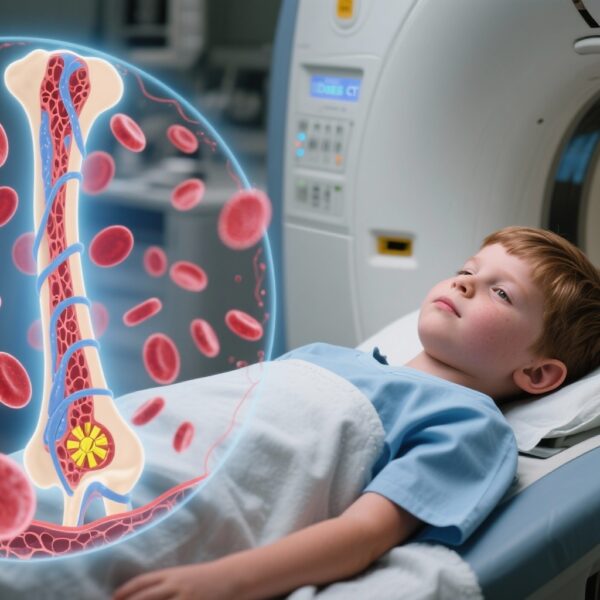Tổng quan
- Băng quấn trẻ sơ sinh được xử lý bằng permethrin giảm đáng kể tỷ lệ mắc sốt rét lâm sàng ở trẻ từ 6-18 tháng tuổi.
- Cán thiệp này đã được đánh giá trong một thử nghiệm ngẫu nhiên, đối chứng giả dược, mù đôi nghiêm ngặt ở Uganda.
- Tác dụng bảo vệ vẫn được quan sát thấy mặc dù cung cấp phổ biến màn chống muỗi được xử lý bằng thuốc diệt côn trùng kéo dài.
- Tần suất phát ban nhẹ hơn nhưng có thể kiểm soát được ở nhóm can thiệp.
Nền tảng nghiên cứu và gánh nặng bệnh tật
Sốt rét vẫn là một trong những nguyên nhân hàng đầu gây tử vong và bệnh tật ở trẻ em ở châu Phi cận Sahara, đóng góp đáng kể vào tỷ lệ tử vong ở trẻ dưới 5 tuổi ở các khu vực có bệnh lưu hành. Mặc dù phân phối rộng rãi màn chống muỗi được xử lý bằng thuốc diệt côn trùng kéo dài (LLINs), các trường hợp sốt rét vẫn tiếp tục xảy ra do các yếu tố như hoạt động còn sót lại của muỗi và việc sử dụng LLIN không nhất quán. Trẻ sơ sinh và trẻ nhỏ (6-18 tháng tuổi) chịu gánh nặng lớn hơn so với các nhóm khác, nhấn mạnh nhu cầu về các biện pháp phòng ngừa bổ sung và phù hợp văn hóa. Bằng cách tận dụng các thực hành chăm sóc trẻ truyền thống, cụ thể là việc sử dụng băng vải quấn trẻ phổ biến của các bà mẹ để mang trẻ trên lưng, nghiên cứu này đánh giá xem việc xử lý các băng vải này bằng permethrin—một chất diệt côn trùng pyrethroid tổng hợp có hiệu quả đã được chứng minh—có thể cung cấp một lớp bảo vệ bổ sung chống lại việc lây truyền sốt rét hay không.
Thiết kế nghiên cứu
Cuộc điều tra này được tiến hành dưới dạng một thử nghiệm ngẫu nhiên, đối chứng giả dược, mù đôi ở Uganda từ tháng 6 năm 2022 đến tháng 4 năm 2024. Đối tượng nghiên cứu bao gồm phụ nữ trưởng thành chăm sóc một đứa trẻ từ 6 đến 18 tháng tuổi, phản ánh một khoảng thời gian quan trọng đối với sự dễ bị tổn thương của sốt rét. Các cặp mẹ-trẻ được ngẫu nhiên phân chia theo tỷ lệ 1:1 để nhận băng quấn trẻ sơ sinh được xử lý bằng permethrin hoặc băng quấn giả dược. Các băng quấn điều trị/đối chứng được tái xử lý mỗi bốn tuần để duy trì hoạt tính diệt côn trùng trong suốt thời gian nghiên cứu 24 tuần. Để đảm bảo tuân thủ bảo vệ cơ bản, tất cả các cặp mẹ-trẻ đều nhận được màn chống muỗi chỉ chứa pyrethroid mới, đại diện cho tiêu chuẩn chăm sóc hiện tại.
Các buổi thăm lâm sàng được lên lịch mỗi hai tuần, với các quy định cho các buổi thăm không theo lịch nếu trẻ phát triển bệnh sốt. Điểm cuối hiệu quả chính là tỷ lệ mắc sốt rét lâm sàng ở trẻ, được xác định bằng sự hiện diện của sốt cộng với kết quả dương tính trên xét nghiệm chẩn đoán nhanh sốt rét (RDT).
Kết quả chính
Trong số 419 cặp mẹ-trẻ được sàng lọc, 400 cặp được ngẫu nhiên phân chia đồng đều giữa nhóm can thiệp và nhóm đối chứng, với tỷ lệ giữ chân và tuân thủ tốt—tỷ lệ tham dự phòng khám đạt 99,9%, và không có người tham gia nào mất liên lạc.
Can thiệp đã mang lại sự giảm đáng kể tỷ lệ mắc sốt rét. Trẻ sử dụng băng quấn được xử lý bằng permethrin có tỷ lệ mắc 0,73 trường hợp sốt rét lâm sàng trên 100 tuần người (khoảng tin cậy 95% [CI], 0,51 đến 1,02), so với 2,14 trường hợp trên 100 tuần người (95% CI, 1,73 đến 2,62) trong nhóm đối chứng. Điều này tương ứng với tỷ lệ tỷ lệ (IRR) là 0,34 (95% CI, 0,23 đến 0,51; P<0,001), cho thấy sự giảm 66% nguy cơ mắc sốt rét lâm sàng có thể quy cho can thiệp.
Các tác dụng phụ bị giới hạn và có thể kiểm soát được. Phát ban được báo cáo nhiều hơn ở nhóm can thiệp (8,5%) so với nhóm đối chứng (6,0%), chủ yếu nhẹ và phù hợp với các tác dụng đã biết của việc tiếp xúc với permethrin, không dẫn đến việc ngừng nghiên cứu.
Phương pháp nghiên cứu nghiêm ngặt—bao gồm việc che giấu, đối chứng giả dược, tỷ lệ theo dõi cao và việc sử dụng LLIN đồng đều—củng cố tính hợp lệ của các kết quả này. Cách tiếp cận bảo vệ nhiều lớp này làm nổi bật lợi ích bổ sung của băng quấn được xử lý bằng permethrin ngoài việc sử dụng màn chống muỗi thông thường.
Bình luận chuyên gia
Nghiên cứu này giới thiệu một chiến lược kiểm soát vectơ sáng tạo được nhúng trong các thực hành nuôi dạy con cái phù hợp văn hóa. Bằng cách sử dụng băng vải quấn trẻ được xử lý bằng permethrin, can thiệp này nhắm mục tiêu vào khung thời gian tiếp xúc quan trọng khi trẻ thường được ôm gần mẹ và có thể dễ bị muỗi đốt, bổ sung cho việc bảo vệ màn chống muỗi chủ yếu vào ban đêm.
Về mặt sinh học, permethrin có hồ sơ an toàn và hiệu quả đã được thiết lập trong việc kiểm soát vectơ. Việc áp dụng nó cho băng quấn trẻ là hợp lý, dựa trên sự tiếp xúc gần và kéo dài với vectơ muỗi trong giờ ban ngày. Sự giảm 66% tỷ lệ mắc sốt rét được quan sát là có ý nghĩa lâm sàng và tương đương với các phương pháp phòng ngừa sốt rét tiêu chuẩn khác.
Mặc dù phát ban đã được ghi nhận, tần suất thấp và mức độ nhẹ cho thấy can thiệp này nói chung là được dung nạp tốt. Tuy nhiên, việc giám sát các phản ứng da tiềm ẩn vẫn cần thiết trong các triển khai tương lai.
Hạn chế bao gồm việc hạn chế địa lý ở Uganda và thời gian theo dõi ngắn 24 tuần; do đó, hiệu quả trên quy mô rộng và an toàn lâu dài cần được xác nhận. Ngoài ra, dân số nghiên cứu có quyền truy cập vào LLINs, và hiệu quả độc lập của can thiệp mà không có màn chống muỗi chưa được thử nghiệm.
Việc tích hợp can thiệp này vào các chương trình kiểm soát sốt rét hiện có có thể tăng cường độ bao phủ bảo vệ, đặc biệt là trong các bối cảnh mà tuân thủ sử dụng LLIN giảm hoặc muỗi đốt vào buổi tối sớm và ban ngày làm suy yếu hiệu quả của màn chống muỗi.
Kết luận
Cuộc thử nghiệm cung cấp bằng chứng vững chắc rằng băng quấn trẻ sơ sinh được xử lý bằng permethrin có thể giảm đáng kể tỷ lệ mắc sốt rét lâm sàng ở trẻ sơ sinh khi sử dụng cùng với màn chống muỗi. Can thiệp này nhạy cảm về văn hóa và dễ thực hiện có thể phục vụ như một phần bổ sung quan trọng cho các chiến lược kiểm soát hiện có ở các khu vực có bệnh sốt rét lưu hành, đặc biệt là ở châu Phi cận Sahara.
Nghiên cứu trong tương lai nên khám phá khả năng mở rộng, hiệu quả về chi phí, an toàn lâu dài và tác động trong các bối cảnh dịch tễ học đa dạng. Trong cuộc chiến chống sốt rét đòi hỏi các cách tiếp cận đa chiều sáng tạo, tận dụng các phong tục chăm sóc con cái bản địa kết hợp với công nghệ diệt côn trùng đã được chứng minh nổi lên như một hướng đi đầy hứa hẹn.
Tài liệu tham khảo
Boyce RM, Shook-Sa BE, Ndizeye R, Baguma E, Giandomenico D, Cassidy CA, Eshun S, Siedner MJ, Staedke SG, Ntaro M, Juliano JJ, Reyes R, Mulogo EM. Permethrin-Treated Baby Wraps for the Prevention of Malaria. N Engl J Med. 2025 Sep 24:10.1056/NEJMoa2501628. doi: 10.1056/NEJMoa2501628. Epub ahead of print. PMID: 40991921; PMCID: PMC12462887.
World Health Organization. World Malaria Report 2023. Geneva: WHO; 2023. Available from: https://www.who.int/publications/i/item/9789240064898
Lengeler C. Insecticide-treated bed nets and curtains for preventing malaria. Cochrane Database Syst Rev. 2004;(2):CD000363. doi:10.1002/14651858.CD000363.pub2.
Ghi chú bổ sung
Với sự kháng thuốc diệt côn trùng ngày càng tăng và việc lây truyền sốt rét vẫn tiếp tục mặc dù sử dụng LLIN, các can thiệp mới như băng quấn được xử lý bằng permethrin có thể đóng vai trò quan trọng trong việc đóng các khoảng trống trong việc phòng ngừa sốt rét. Sự phù hợp với các thực hành văn hóa địa phương tăng cường khả năng chấp nhận và bền vững tiềm năng.




Hey there just wanted to give you a quick heads up. The words in your post seem to be running off the screen in Chrome. I’m not sure if this is a formatting issue or something to do with browser compatibility but I thought I’d post to let you know. The style and design look great though! Hope you get the issue solved soon. Many thanks